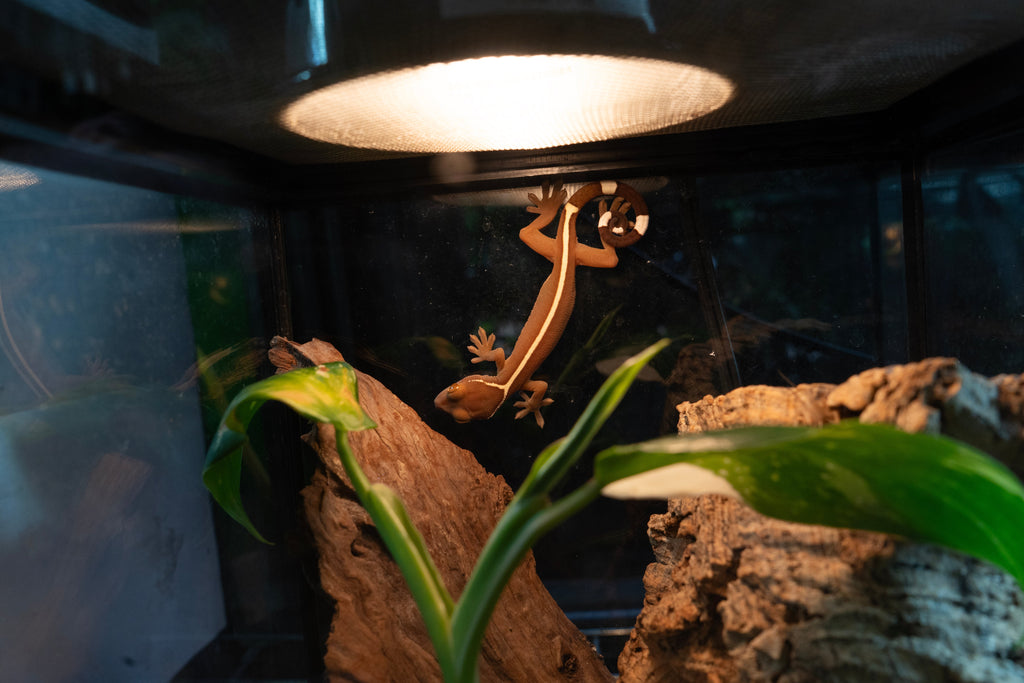Skunk Gecko (Gecko Vittatus) Caresheet

Skunk Gecko (Gekko vittatus) Care Sheet
Written by Joshua Halter.
Updated and checked on 9/30/2025
Skunk Geckos, also known as white-lined Geckos, are captivating, nocturnal reptiles native to the tropical forests of Southeast Asia. At The Bio Dude, we've successfully bred these geckos in-house for several years, and we're excited to share our expertise to help you provide optimal care. They are very protective of their young, and will form little groups within their hierarchy. We're thrilled to share these easy-to-breed, personality-filled critters with you.
Enclosure Setup
-
Size: These lizards are very active, and require a large amount of space. It is recommended to have a vertically oriented habitat to provide them the canopy and emergent layer that they are used to in the wild. A single gecko can live comfortably in an 18" x 18" x 24", for more than one it is recommend to have at least a 24" x 24"x 24". At The Bio Dude, we are proud to offer many different arboreal habitats, and have successfully bred our group in a 24" x 24" x 36". The larger of a habitat you provide them, the more active they will be. It is not recommended to do anything smaller than above, even for babies as their temperature and humidity demands can be hard to replicate in a small habitat.
-
Substrate and Drainage Layer: These geckos tend to spend the majority of their time in the undercanopy and canopy layer of the Asian rainforest. Due to this, varying humidity and temperature swings are very common, and should be replicated within your terrarium as extensively as possible. To facilitate this, we recommended utilizing a Terra Fauna bioactive kit. This kit will include your drainage layer, screen divider, bioactive substrate with all necessary biodegradables. It is important that your substrate drains very effectively while allowing for humidity swings and spikes throughout the day. It is recommended to have at least a 2" drainage layer and 3" of proper bioactive substrate.
-
Clean up Crew: In a bioactive setup, include your Tropical Springtails, larger/robust isopods, such as Dairy Cow isopods to work the top layer and Dwarf Whites to work the middle and bottom. Most importantly, do not forget a biological driver such as Bioshot and leaf litter or cork pieces, thoroughly mixed with your substrate.
-
Branches, Woods and Decor:
Add different level of branching such as ghostwood, cork bark, Mopani wood and jungle vines to offer natural climbing, foraging, hiding and hunting opportunities. Be sure that all wood accents are secure in place, as these geckos will jump and try to move the branches. We found cork bark tubes are one of their favorites, as long as the tube is wide enough to fit the gecko inside easily. They will also lay their eggs on the insides and outside of various woods, such as cork bark. Plants are extremely important to this species. Larger, broader leaved plants are recommended for them. With their high activity level, it is recommended to ensure that the plants can not only handle the weight, but also handle being jumped on and occasionally broken when they use them for resting or jumping. Plants such as Aglaonema, Pothos, Philodendron, Schefflera, tillandsias and bromeliads are excellent choices. Mounting the bromeliads epiphytically with the Bio Dude's Bromeliad Mounting Clips will also create opportunity zones for hydration, as their axels hold water. Be sure to properly rinse, de-dirt and disinfect your plants prior to introducing them into your habitat.


Temperature, Lighting & Humidity
Temperature gradients
-
Ambient (cool side): 78–85 °F (24–27 °C)
It is recommended to utilize a Halogen Heat bulb that emits IRA and IRB, such as the Arcadia heat bulb placed into an overhead reptile heat dome of appropriate size. If you are having issues regulating the above gradients, utilize a thermostat to ensure you are providing proper temperatures in each area. Utilizing a Bio Dude thermometer/hygrometer will also help ensure your above parameters are correct.
Lighting & UVB
-
Though crepuscular, a mid-Ferguson zone UVB, such as the Arcadia 6% is strongly recommended to promote calcium metabolism and natural behavior. If you are providing UVB, be sure to use a calcium supplement that does NOT include D3. It is recommended to utilize a Bio Dude Solar Lamp Fixture to house the individual UVB. From there you can connect that fixture via daisy chain to the Bio Dude Solar Grow LED for your live plants.
-
Use a 10–12 HR photoperiod, shifting seasonally (10 h in winter, up to 14 h in summer).
-
Place the UVB fixture so it’s unobstructed (no glass/plastic between bulb and animal). Be sure to utilize a Solar Meter to check the Ferguson Zone you are providing and ensure you're hitting the correct area of the spectrum within your tank.
-
Replace UVB bulbs every 6–12 months (even if the light still functions) because output declines. Utilize a Solar Meter to confirm this and follow the manufacturer's instructions.
Humidity & shedding
-
Keep ambient humidity around 50% and provide one moderate spike at bedtime to about 75%. A spray bottle can be utilized to help maintain this as well as a misting system.
-
During shedding, it is important to check the toes of your gecko. Leftover skin or incomplete sheds should be carefully removed. Leftover shed can cause toes to fall off! This is not near as common with this species, but leftover shed can be a sign of incorrect husbandry and can lead to long term health issues.
Diet, Feeding & Supplements
Feeding frequency & prey size
-
Juveniles: feed daily. A varied diet is of paramount importance.
-
Adults: feed every other day or 3–4× per week. A varied diet is of paramount importance.
-
Offer prey items not exceeding the width of the space between the geckos eyes (e.g. small crickets, dubia roaches, black soldier fly larvae, silkworms). Adult geckos can even be offered day old pinkies for ovulating females. Anything larger than that can cause injury or internal issues and is not recommended.
- Do not feed them superworms. They are unable to digest them fully and can cause internal issues.
-
Waxworms or butterworms can be occasional treats (sparingly, as fat sources).
- An elevated feeding bowl can be utilized with species. They are also able to be trained to be tong-fed, which is always a bunch of fun!
-
Gutloading & supplementation
-
Gutload insects 24–48 h prior to feeding with high‐quality diets such as the Bio Dude's Bug Grub, carrots, cucumbers and leafy greens. Remove any uneaten food 24 hours after providing.
-
Dust feeders with calcium (without D3 if you are providing UVB, or with D3 if you are NOT providing UVB) at most feedings (adults every other feeding). We recommend Repashy Calcium Plus.
-
Use a multivitamin supplement occasionally (e.g. once weekly). Do not mix the Calcium with your multivitamin as they will offset. We recommend Repashy Supervite.
-
Offer a shallow dish of clean water daily (change daily and disinfect often to prevent bacterial buildup). If you are seeing your feeder insects, isopods or springtails drown feel free to put a tiny piece of cork in the bowl (it will float) and give these critters a way out without stagnating the water source.
Handling & Health Notes
-
Skunk Geckos are somewhat sensitive and prefer minimal handling. Over handling can stress them and provoke them to drop their tails. While they can regenerate this is a very traumatic and a high energy cost for them to pay. Understand your geckos body language when holding and interacting so you are able to slowly build up that trust.
-
Always wash hands before and after handling.
- These geckos can be very vocal, especially at night. This is normal! So be sure to know this before you pull the trigger on these guys, like their cousins, Tokay Geckos, they love to talk trash!
-
- Josh Halter










